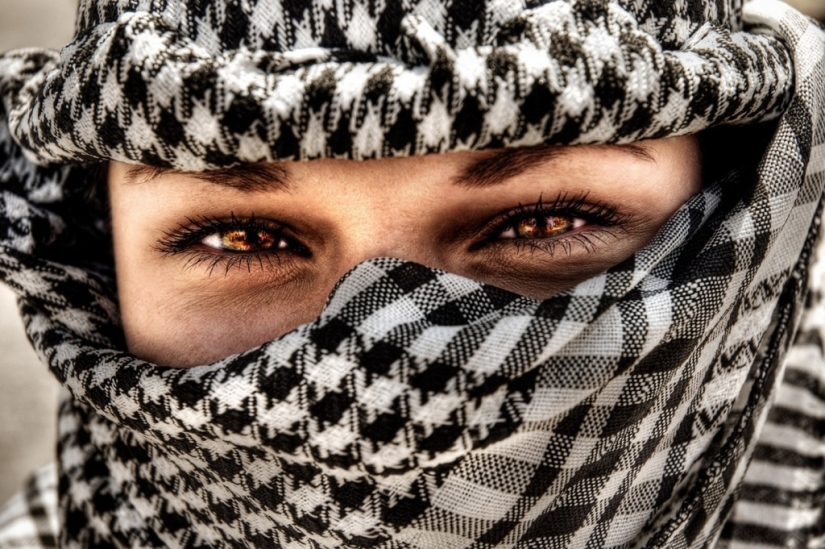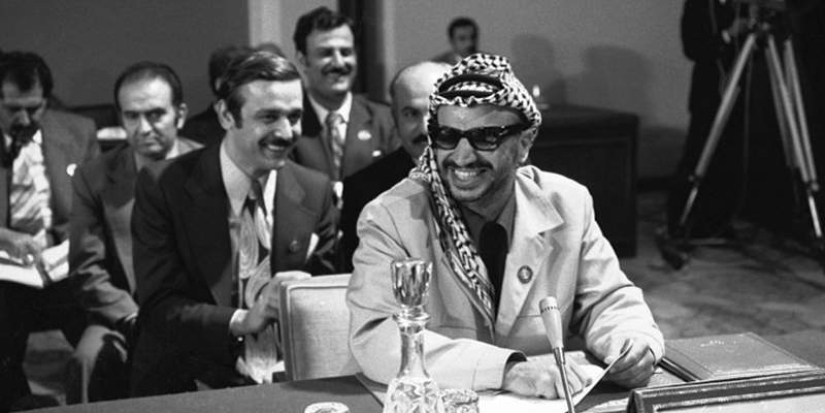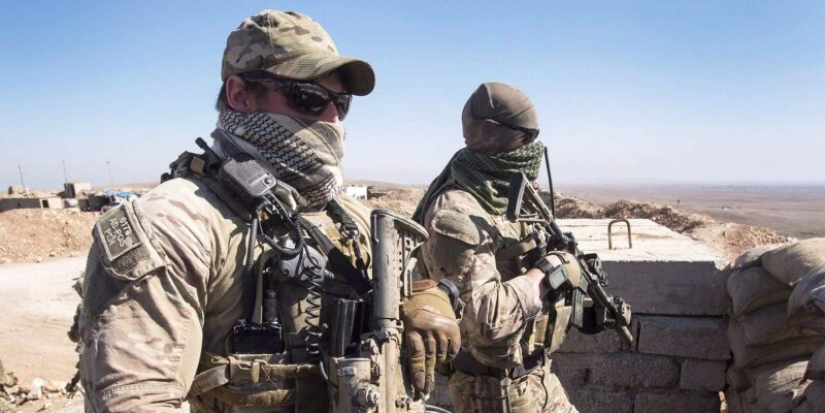Arafatka: how Arab head scarf has won the love of the military and fashionistas of the planet
Keffiyeh, shemagh, arafatka — different names for the square scarf with a distinctive pattern. In the XX century it was worn by Palestinian rebels and the British commandos, it symbolized the exotic Arab, left-wing views and the image of the "terrorist in spherical vacuum". Since the beginning of the XXI century keffiyeh is so firmly established in the global military and civil fashion, that its historical sense began to dissolve.

The beginning of the third decade of the XXI century the image of a fighter of the special forces of almost any country in the world includes keffiyeh protective coloring. Her are the soldiers of the armed forces "simpler", and also fighters with mercenaries of all stripes.
The universal love of the military to arapatka not accidental. Scarves of thin cotton fabric is good in any weather. In the heat of the keffiyeh protects from the sun, blown by the air and absorbs sweat. Cold — works as a scarf. It can be tied on the face, hiding him from unwanted glances or dust.

"Helper functions" Semaga very extensive. Someone is injured and there are no complete kits? Here you dressing the fabric for fixing the damaged limb. Keffiyeh can be rolled into a bundle and use as short a rope and you can put things in it and rolled it up in a knot.
Suitable keffiyeh and to partially filter is too dirty, full of water turbidity and as a towel. It can help to take a hot kettle or spread it like a tablecloth on a halt. It can even become a weapon: it is enough to turn a scarf into a sling and to find a suitable stone or to use as a noose.
Gregory Cowherd, field EA in stock:
"Forgotten the main function in arafatki can amazing tacticle to be photographed. Dunce with Kalamata no surprise. Dunce with Kalamata in dark glasses and arafatki is another matter.
Arafatka pulled down over his face, covering pimples, swelling after yesterday's excesses, total nechistoty — and inform the carrier of the mysterious and threatening zagadochnoi. God made people beautiful and not very brutal looking and looking home. Arafatka same as Colonel Colt and Sergeant Kalashnikov has blurred the boundary between the strong and the weak."
Well, in time of peace arafatki can be seen on the fashionistas of different views and tastes — from the Bohemian hipsters in the UC Berkeley campus to neo-Nazis in East Berlin.
The traditional headdress of the inhabitants of hot and dry regions of Asia and Africa — the turban and the turban. Known since the bronze age scarf with a length of several meters, which can fold in on your head a thousand different ways. It creates a "pillow" of fabric layers and the air and protects from the scorching sun, and cold at night. Turbans can be made from a variety of tissues, including the stupendously high.
Keffiyeh, or shemagh, much more simple and cheap item of apparel. In expanded form it is not cloth, but a square scarf, usually made of cotton. Cheap, convenient, functional.

The Palestinians, who consider keffiyeh their national clothes, give the palm to residents of the Iraqi city of Kufa. From this name comes the word "keffiyeh" — kutski handkerchief.
If you dig deeper, traces of square scarves with patterns and characteristic fringe go to the mountains and valleys of Kurdistan. Kurdish warriors of both sexes still love to combine military clothing with a scarf as a keffiyeh Palestinian and Jordanian, as well as more traditional, with bright and colorful patterns.

Probably the way of origin kufii was. In al-Kufa, "the entry point" Arabian caravans from the desert in Central Mesopotamia and Baghdad, faced the Bedouin and the Kurds. Simple caravan participants appreciated the convenience, the cheapness and versatility of the Kurdish square handkerchief compared to the traditional turban.
They also supplemented it with a aGal — folded in two rings on the reins of goat hair, which can be pressed against the kerchief on her head. Fashion has swept Arabia and caravans spread to Syria and Palestine.
And here's a simple one-color pattern was born as a local fashion Palestine and TRANS-Jordan fellahs and Bedouins. Lawrence of Arabia wore white or solid color scarf in desert fashion, or richly patterned Bedouin of the Arabian desert used such.
In addition, residents of the desert made shawls dense, of a mixture of cotton and wool fabrics in order to survive in the brutal heat of the day and deadly cold of the desert night. The Palestinian peasant fellahin lived in a milder climate, and a lightweight cotton it is usually enough.
By the end of the Ottoman rule in Palestine keffiyeh was a sign of peasant or fellah nomad-Bedouin. Military officials and wealthy citizens, or "Effendi", the "pure public", chose to wear a FEZ — came from the Moroccan city of FEZ, which became a symbol pozdneosennee dress code.
Kopiami enjoyed by those who had to spend a lot of time in the fields and wastelands, were peasants and Bedouins. It is these layers to the 1930-th years came in violent conflict with the Jews-colonists.

The Zionists wanted to build a state in the homeland of the forefathers, may there for many centuries, and lived mostly Muslims. They all hook or by crook bought from local landowners land. Dwelling on the purchased land of the peasants, the fellahin, the Zionist chased.
The intent of the colonists, they had somewhere to go: the Arab world is huge — from the Moroccan coast and the Saharan Sands to the foothills of the Iranian mountains. And the land the Zionists wanted to handle it themselves, from ideological desire to "become a people of merchants and artisans a nation of peasants". The Arabs tried not to even hire seasonal laborers.

Fellahs to go anywhere not going: even if their grandfathers in the nineteenth century, moved here from Egypt itself, they have considered the local, and the Jews — creating obscenity "newcomers". The Palestinian Arabs even in neighbouring Syria — no more a stranger than a Syrian Kurd. Driven from land fellahs had not emigrated and settled in the slums of the cities. They thirsted for land and revenge.
But the city public, the venerable Effendi in fezzes., the British tried not to touch. In 1938 the leaders of the Palestinian nationalists appealed to the citizens with "an earnest request" to have the habit of wearing scarves. In a sign of solidarity and to action-fellahin make it easier to get lost in the city streets.
So even before Arafat's keffiyeh has become a symbol of Palestinian resistance and nationalism. She usually had a black pattern in the form of fishing nets.
Lawrence of Arabia wanted to see the huge Arab monarchy under the hand of the descendants of the prophet Muhammad, the sheriffs of Mecca from the house of the Hashemites. It is at the beginning of the Arab revolt, the British had promised his friend, the king of Hejaz Hussein Ibn Ali.
But the gentlemen to the West and East of Suez considered that the promises made during the war the British Empire to keep do not have. The Hashemites instead of a huge pan-Arab Empire from the Indian ocean to Turkey managed to keep only a piece of land beyond Jordan.

There came with king Bedouin of Hejaz exiles, companions of Lawrence, began to establish a difficult neighbourhood with local fellahin. At this time, after the First world war, there was a very characteristic appearance kufii of the Royal guard and the Hashemites: the small red pattern, almost chess, and Bedouin-dense fabric blend of wool and cotton.
The king of Transjordan Abdullah bin Hussein of the Hashemite house chose the former offense, the preservation and deepening of cooperation with London. The British responded by helping his most faithful ally in the Arab world to create an Arab Legion: highly professional, modern fighting force, not inferior in efficiency to the best parts of the Royal army. Kufii with a red pattern become part of the uniform.
Fighting shoulder to shoulder with the Jordanian Legion, the British soldiers quickly learned all of the convenience and benefits of kufii in the desert war. During the battles with Rommel in North Africa, the keffiyeh has become an integral part of all the fighters of the group long-range reconnaissance of the desert and the SAS, who had a lot of time in deep raids in the sand and wastelands.
When in 1967 the Israelis took control of the West Bank of the Jordan river and the Gaza strip, local launched a guerrilla war. The world of the late 60's, passionate about anti-imperialism, the struggle for civil rights and a left wave, seen in the photographs in the Newspapers and in the newsreel, as heavily armed Israeli soldiers beat and dragged to the dungeons of the insurgents in the typical colorful shawls.
Image kufii "superimposed" on the traditional scarves by the Vietcong: also in the small black and red pattern. Progressive, leftist and anti-imperialist activists tried to get something like this and flaunt this in spite of the aggressor. The Vietnam war was soon over — but the Arab-Israeli conflict to do it and thought.

After world war II and the defeat in the War of independence of Israel, the Palestinians and other Arab peoples were enthusiastic pursuit of modernization and Europeanization.
Keffiyeh is preserved in the everyday life of the Palestinians, but gradually became part of "grandfather's closet".
Even the PFLP (popular front for the liberation of Palestine) and Fatah (Movement for the national liberation of Palestine) then often preferred to dress in Western fashion, and to organize terrorist attacks in trendy bell-bottoms and colorful shirts.
With all mediaresource keffiyeh could be forgotten exotic to the 80s, if Yasser Arafat decided to make her their personal symbol. Other Palestinian leaders preferred to suits and ties or military uniforms — but Arafat appeared everywhere in kufii. He soon came up with to wear it in a special way that it resembled the conventional map of Palestine (aka conditional map of Israel).
Since the 70s in the 90s Arafat was one of the most popular characters in global media. Some hated him, others loved, but knew everything. And arafatki, too. The militants and activists of the Palestinian organizations are increasingly wore the keffiyeh is not the habit and to quickly hide the face — and as a political statement, a symbol of their views.
Well, after numerous high-profile terrorist attacks by the end of the 80s arafatka was for Hollywood reliable marker of an Arab terrorist, spherical in vacuum. Who wants to kill everyone just because a very angry and runs, yells with a "Kalashnikov" at the ready directly into the bullets of good guys.
By the end of the 90s it seemed that the reputation of kufii in the eyes of the West — and that means that global media culture is hopelessly corrupt. Symbolically she was somewhere nearby with his explosive suicide belt. Sympathy for the Palestinians after the failure of the peace process and the wave of terrorist attacks against civil also started to melt.
However, the most perspicacious of the fashion houses caught some "fluctuations in the noosphere". In January 2001 the guardian wrote about "terrorist chic masculinity" as the future trend of the season autumn-winter 2001-2002.

Nakarkal. In September collapsed towers of the world trade center. And then the neoconservatives, the United States decided that, under the guise to overthrow Saddam and to turn Iraq into a testing ground of experiment to transform a totalitarian regime into a society of liberal democracy.
Masses of American troops for many years was in Afghanistan and Iraq. In both countries, the keffiyeh was traditional clothes — but there was the strongest sympathy for the Palestinians: the us occupation, many believed the "machinations of the Zionists against Muslims." Arafatki become one of the ways to designate "Fig in the pocket", as well as an important part of a variety of anti-American militants.
At the same time came the Americans, British troops had the tradition to use on such kopiami TVD — which is usually called temagami — since the Second world war. It is unknown who it was from the special forces of US picked up the habit to wear a keffiyeh from his enemies or allies, but they very much.
Naturally, the fashion police have covered and "regular" soldiers, Marines and Chuksikem. In the first years of the occupation of Iraq and Afghanistan tactical shemagh has become as a regular feature of the appearance of the US soldier as the helmet, body armor and M4.
Well, Americans as legislators, army fashion is picked up, and many others. Including those who prefer to including the Pentagon in the section "most probable enemies". After all, the keffiyeh is not PI... Americans and freedom-loving Palestinians!
Past fashion trend of tacticalness could not pass lovers of the military style, especially airsofters and "raptors". Kufii become increasingly flashed on the streets of cities without any connection with left-wing sympathies or support palestnitsev.
Already by 2007, "new York times" stated: the keffiyeh-shemagh lost its political connotations and has become part of the global fashion cities from Frisco to Tokyo. And in the 2010s has become quite a common sight of German neo-Nazis with aruvadai, ziguyuschih against the influx of the Muslim refugees.

With the Arab keffiyeh do not confuse tagelmust Tuareg of the Sahara. It is also usually made from cotton, but instead of colored patterns on white cloth entirely painted in dark-blue color.
Form of tagelmust is not a square, and the cloth of several meters. This is largely a ritual thing, a man-a Tuareg traditionally wears it constantly. Not on the head or neck, like an Arab keffiyeh, and completely tied, leaving open only the eyes.
It is believed that tagelmust protects the wearer not only from desert winds and evil spirits. As keffiyeh, he broke into the Western fashion, mostly French, for the native lands of the Tuareg were a part of colonial Empire in Paris. French fashionistas wear it like a scarf, but the rest of the world he has and shares popularity arafatki.
And the Legionnaires and "not-quite-colonial" troops Marin tagelmust used for its intended purpose when fighting in deserts. Including the Tuareg.

No matter how saddened Palestinian activists, to make a keffiyeh a symbol again will not happen. Kurdish scarf, which became the clothing of the Arabian Bedouin and the fellahin of the valley of the Jordan, finally has globalized.
Now it is worn all the progressive hipsters-pacifists and Japanese nonconformists from Akihabara to dream of race war neo-Nazis, the spirit can not digest all Arab and Muslim.
Anyone can pick up the symbolic meaning and practical application to your taste. Shemag is the anti-colonial struggle and the American turboparts, item Bohemian chic and handy thing on the camping trip.
Moreover, it is really beautiful and practical thing.
Keywords: The Arabs | The military | Clothes | Planet
Post News ArticleRecent articles

American artist Lee Price is sure that eating is a completely natural process, but many are ashamed of their attitude to food, ...

There is an unusual exhibit at the National Museum of Natural History in Washington. This is the skeleton of a man, on whose chest ...
Related articles

Nuclear suitcase President of the United States know everything. But about what it is and how it works, known only to the elite. ...

Gestures play an important role in our lives. Thanks to this means of communication, people communicated before there was language ...

When it comes to bad habits of men, immediately come to mind are Smoking and alcohol. Someone may still remember the cravings, nail ...

A series of works by photographer Brian VILS from new York, dedicated to girls, sheltered the homeless and abandoned cats. 'brien ...